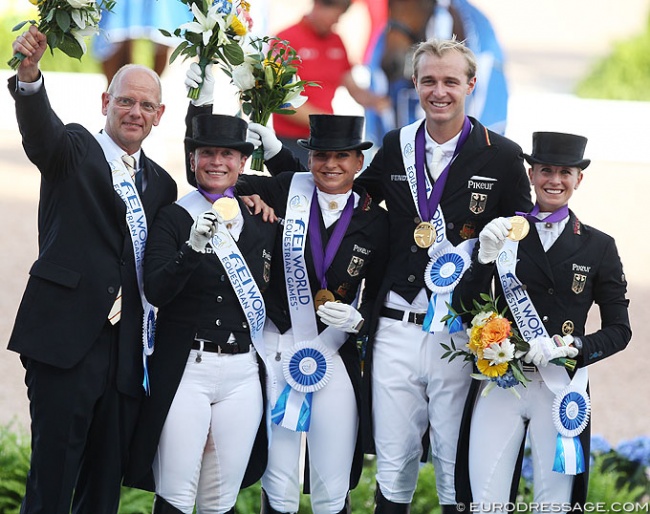
Like conquistadors sweeping in to stake their claim of new territory, the German dressage team came to the U.S.A. to wield the axe of power in the team competition at the 2018 World Equestrian Games in Tryon and take out yet another WEG team gold medal. Home team U.S.A. got silver and Great Britain grabbed bronze.
First a Few Observations
Two years ago Mark Bellissimo took up the challenge to stage a WEG in Tryon, but the show venue is far from completed. It is a pity that riders, press and visitors met such an unfinished conditions at the show grounds and construction workers continue to build the facilities with noises of hammering, stapling, chopping, cementing, dragging, rolling, persisting each official show day. The main stadium, however, is done and for horse, rider and groom everything is in place for ideal showing conditions. The hot and humid weather in the lead up to Hurricane Florence’s torrential rain predicted for Saturday are an extra challenge that will be faced head on.
The 2018 World Equestrian Games kicked off with the Grand Prix test which served as team competition. With 77 combinations competing, the class was split up over two days. The FEI’s ridiculous group system draw (with the riders of the strongest nations getting to start last in one group) not only creates an unlevel field of play going against the grain of fair judging (as it has been scientifically proven that the judging marks go up towards the end of a class due to natural bias and comparison), but also leads to empty stands in the morning sessions when the ‘weaker’ riders go, and just short periods of filled seats for the besties. QED the empty seats in many of the photos!
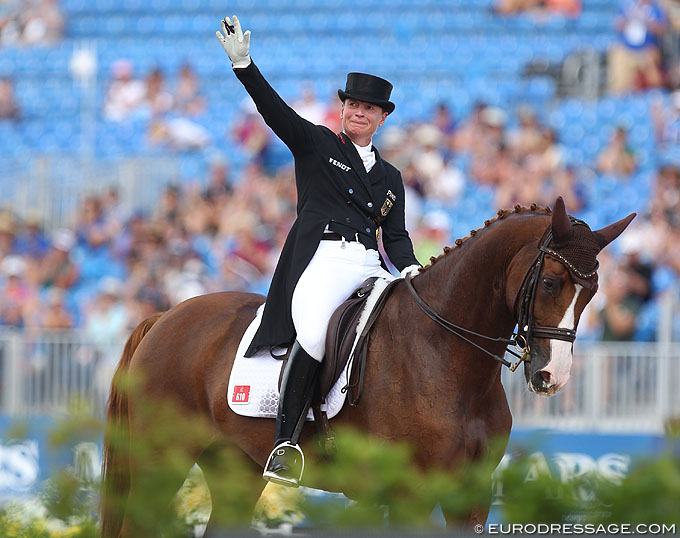
Another observation worth noting is that the WEG takes place in September, which is quite late in the season. For many horses the pressure of qualifying for their country’s team this spring and summer and then having to peak again in September took a toll on their health. Especially on day two no less than 5 dressage horses appeared incredibly fragile on their legs and were unlevel in the trot extensions and half passes, but no bell was ever rung for elimination.
Germany, a League of Its Own
The German team were the hot favourites for the team gold medal but their dominance in Tryon was even more impressive than anticipated. A jaw dropping personal best score of 84.829% for Isabell Werth and Bella Rose made the big difference. The panel of judges for the Grand Prix included Susan Hoevenaars (AUS), Andrew Gardner (GBR), Mariette Sanders-Van Gansewinkel (NED), Katrina Wust (GER), Anne Gribbons (USA), Hans-Christian Matthiesen (DEN), and Annette Fransen-Iacobaeus (SWE) and they were unanimous that Werth and her 14-year old Bella Rose (by Belissimo M x Cacir AA) is their flavour of the show.

Everyone thought that Tryon would be Sönke Rothenberger and Cosmo’s moment to take over the baton from Isabell Werth after the pair was robbed of a gold medal at the 2017 European Championships in Gothenburg. However, the come back of Bella Rose has put a spanner in the works. With their 84.829% Grand Prix score for Bella Rose the judges have now indicated which horse is their favourite for gold this weekend and Rothenberger will have to be absolutely fault-free if he wants to turn potential bronze or silver into gold.
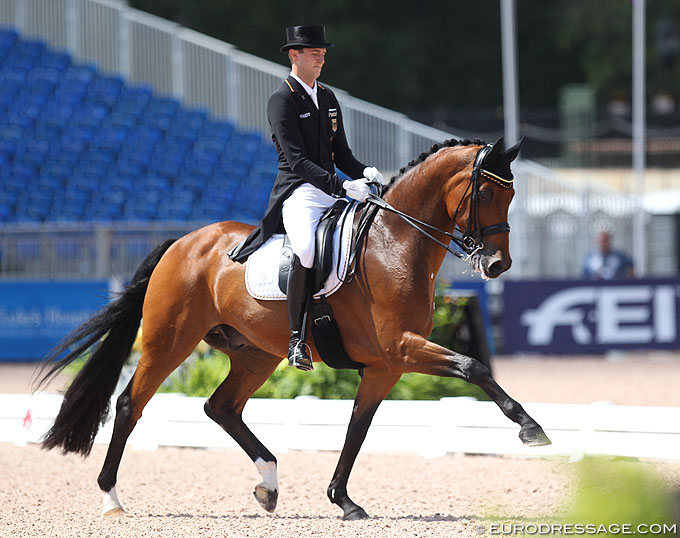
Germany’s team total was 242.950 points, almost a full 10 percent ahead of Team U.S.A.! The third German score came from team rookie Jessica von Bredow-Werndl on Beatrice Burchler-Keller’s 11-year old Trakehner mare Dalera BB (by Easy Game x Handryk), who was the overnight leader in group 1 with 76.677%. While the mare does not achieve much overstep in the trot extensions and needed more bending in the rib cage in the half passes, the passage work was lovely and the piaffes had good sit. Germany’s fourth pair – Dorothee Schneider on Sammy Davis Jr – finished 13th with 75.062%.
Team U.S.A. Clear for Silver

As last rider to go on day two, Laura Graves and the 16-year old Dutch gelding Verdades (by Florett As x Goya) had everything working in her favour: best starting place, a star reputation, and competing on home soil. Despite feeling under the weather health wise, Graves pulled it together for the Grand Prix and rode on an adrenaline rush. Her halt at entry was one of the best ones. The trot extensions were massive in ground cover, even though the first one was quick in tempo. The half passes and passage were lovely, the piaffe remains the biggest weak point of the horse as his conformation does not allow him to sit and take the weight. Even though Verdades keeps a good rhythm, he leans on his bum and does not take the weight properly. The extended walk had good overtrack but not enough stretch over the back and the nose needed to be more out (7.0). The tempi changes were very nice, but the horse completely lost the 3-beat canter rhythm on the center line for the pirouettes, which led to a very early bent to the right and a lack of striding in the right pirouette. Also in the zig zag the horse was bent to the right very early for the right half passes. While the passage on the final centerline was fantastic, the horse swung the right hind leg far out from under the body in the piaffe at X. Graves and Verdades always charm with their soft, light and effortless bridle contact. The pair got 81.537% with 79.565% (GBR) as low score and 85.109% (USA) as high score!
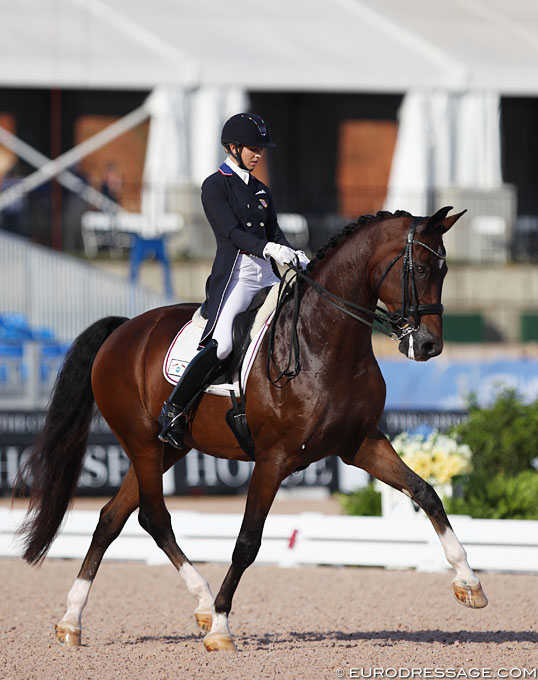
America’s third score came from Adrienne Lyle on Betsy Juliano’s 11-year old Hanoverian stallion Salvino (by Sandro Hit x Donnerhall). The gorgeous black stallion is not the easiest ride as he does not truly stretch into the contact, but he certainly has some great moments. The half passes had good rhythm and in piaffe the horse can take the weight on the hind legs. The passage has a gorgeous side silhouette, but the horse is often crooked and is disconnected in the fore and hindquarters in it. The extended walk was great and also in the collected he maintains a good rhythm. In canter the stallion needs to stay more on the hindquarters as he has a tendency to drop on the forehand but the one tempi’s were lovely. They scored 74.860% for 14th place.
Steffen Peters and Akiko Yamazaki’s 10-year old Dutch warmblood gelding Suppenkasper (by Spielberg x Krack C) finished 18th with 73.494%. The bay gelding fortunately showed some improvement from Aachen with the spectacularly energetic passage being a bit more balanced already and closed in the front legs, but the transitions to and from piaffe are still hard. The trot extensions were powerful and the left pirouette was great.
Britain Bags Bronze

In her first ever proper international show against some serious competition, Charlotte Dujardin and Emma Blundell’s 9-year old Hanoverian mare Mount St. John Freestyle (by Fidermark x Donnerhall) landed fifth place with 77.764%, Britain’s best result. Freestyle is the youngest horse in the class and her talent is undeniable. Dujardin’s eagerness to be back in the spotlight and part of the game shows too. The pair did the CDI Joosland in April on the European continent and then three more smaller CDI’s in the U.K. as preparation for Tryon. In each award ceremony Freestyle shows such extravagant movements, legs flying all over the place. She gives so much to her rider and hopefully her body will be able to sustain such power and elasticity for the long run. It will require good management to maintain her for the future, because there is so much more in the tank.
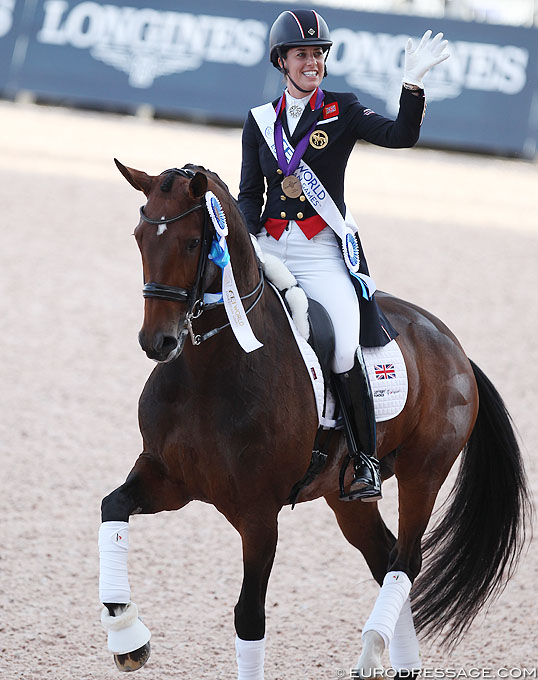
Charlotte’s trainer Carl Hester landed right behind her in sixth place with 77.283%. Aboard Anne Evans and Ann Corry’s 10-year old British bred Hanoverian gelding Hawtins Delicato (by Diamond Hit) Hester showed what real dressage training is like. The dark bay gelding is not the fanciest mover, but Carl did such an incredible job getting the best out of this rising star. The half passes were smooth, the second trot extension was better than the first. The horse is regularly in the passage, but sometimes the hindlegs trail. The first transition into piaffe was shuffling, but the horse found a good rhythm and sit in piaffe and stayed on the spot. The extended canter had good power, but needed more lengthening of the frame. The zig zag was solid, the one tempi changes were straight but could be more ground covering. The left pirouette was big and required more collection, the right one was big and counterbent (7.3). Throughout Delicato was steady in the bridle. The final piaffe at X was small but regular.
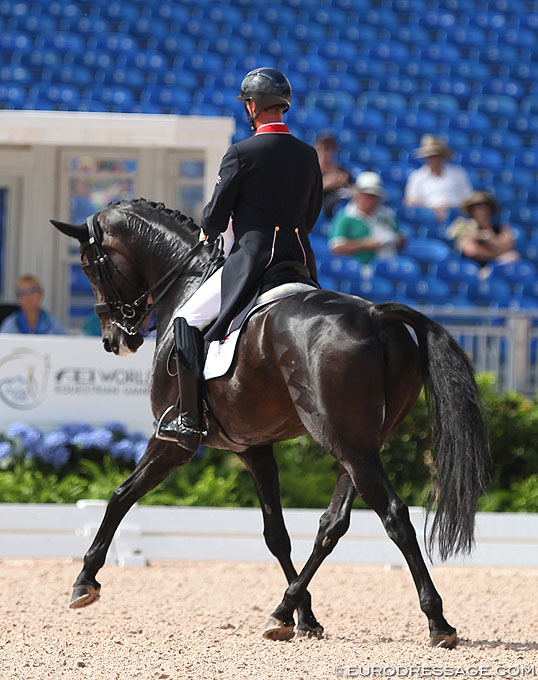
Britain’s fourth rider was Emile Faurie on Hof Kasselmann’s 11-year old Oldenburg gelding Dono di Maggio (by Dimaggio x Santander). They landed 22nd place with 72.795%. The passage was exceptional and also in piaffe the chestnut showed great lift and energy but could sit a bit more behind. A mistake in the rhythm in the trot extension tampered with a higher score.
Sweden a Close Fourth
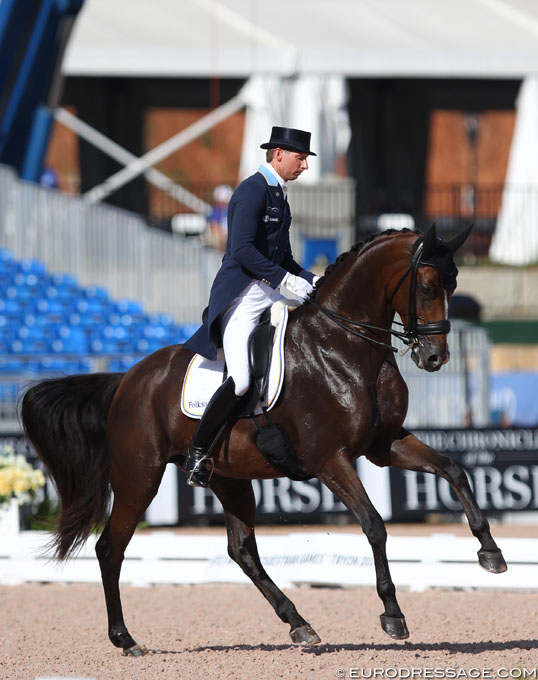
Team anchor was Patrik Kittel on his newest star, Françoise Trembley’s 11-year old Swiss warmblood mare Well Done de la Roche CMF (by Furstentraum x Walt Disney). He finished fourth on a personal best score of 78.199%. Well Done is a super talent mare. She is gorgeous, feminine, lightfooted and has amazing talent in piaffe and passage, but the mare just does not feel settled in the show ring and is as tight in the back as the strings on a fiddle stick. Kittel tries hard to make her feel comfortable and unpressured in the arena, but the tight curb rein does not help for her to chew and relax in the mouth. Well Done get quick and hurried in the tempo in the trot extensions without swing in the back, but the trot half passes were very elegant. The passage is very elegant and expressive but in the first piaffe she was static with no real suspension on the diagonals. The walk was a challenge to make her relax and achieve overtrack (6.3) but in canter she started to feel more comfortable. The zig zag was good, the two tempi changes nice but in the ones there was too much swing in the body due to the rider’s seat. The right pirouette was nice, the left one was also good but the balance needed to improve in that one. Kittel’s high scores were very interesting as the judges had him between 76.848% (GBR, USA) and a patriotic nod from the Swedish judge with her 81.1976%.
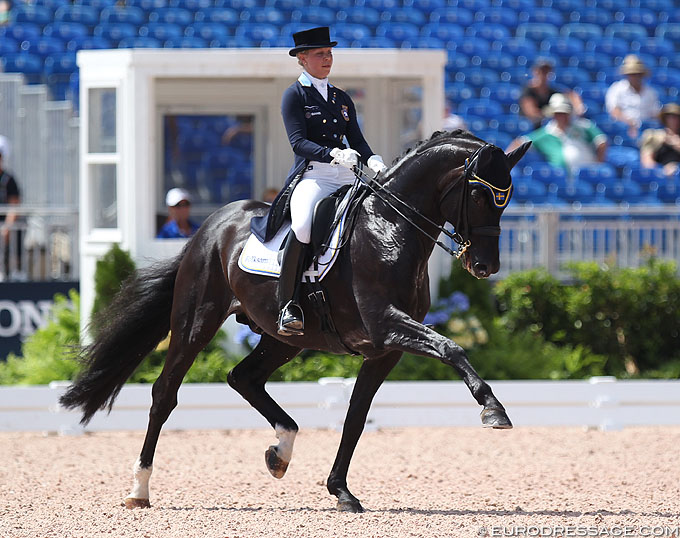
Juliette Ramel and her 12-year old Buriel KH (by Osmium x Krack C) impressed with wonderful piaffe-passage work. The trot extensions lacked energy and lengthening of the frame though, yet the horse easily achieves overtrack. There could have been more bending in the rib cage in the half passes and the extended walk barely had any overtrack or stretch, but the collected walk was clear in rhythm. Buriel showed some strong canter work with a solid zig zag, an uphill extended canter and good tempi changes. In the left pirouette the canter was lost. They scored 75.248% for 12th place.
Holland Completes Top Five
The Dutch team finished in fifth place with 223.664 points. Spain followed in sixth place with 220.180 points and these top six nations have now officially qualified a team for the 2020 Olympic Games in Tokyo.
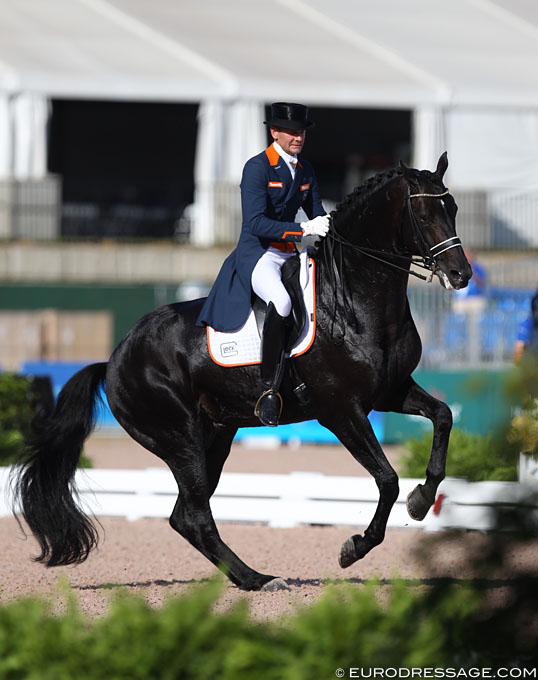
Hans Peter Minderhoud and Gaston Glock’s 10-year old Dutch warmblood stallion Dream Boy (by Vivaldi x Ferro) probably had one of the most challenging rides in the Grand Prix riding in a torrential downpour of rain on Wednesday. The black stallion stayed focused though and showed good energy despite rain lashing in his face. The trot extensions were big, the half pass right a bit hectic. The young stallion was still a bit unbalanced in piaffe getting wide in front and the hocks high, but the passage is expressive. A mistake in the two tempi changes reduced the score to a 73.509% and a 17th place.
Madeleine Witte-Vrees and the 11-year old Dutch warmblood stallion Cennin (by Vivaldi x Donnerhall) produced the third team score of 72.966% and placed 20th. The trot and walk extensions were excellent, but in passage the horse lost power behind and in the piaffe he dropped on the forehand. The one tempi changes were great and the pirouettes ok. Overall the contact was too strong though.
Emmelie Scholtens made her major championship Grand Prix team debut on Ad Valk’s 13-year old Dutch warmblood stallion Apache (by UB40 x Krack C). The stallion had to be flown first class to Tryon in his own container, for which the owner had to pay the two extra stalls himself, because the horse is too stalliony around other horses. Safely arrived in the U.S.A., Scholtens and Apache scored 72.733% to place 23rd.
Text and Photos © Astrid Appels (sorry for the typos, in a hurry as always) - No reproduction allowed
Eurodressage is on the scene to cover this event and take photographers. Interested in photos for social media use or prints, contact us
Related Link
Eurodressage Coverage of the 2018 World Equestrian Games